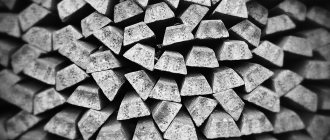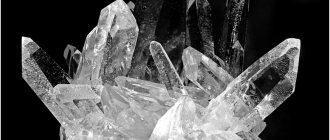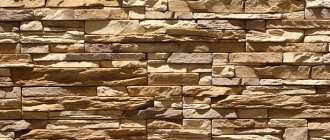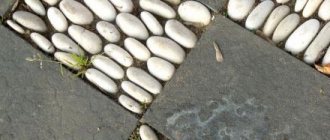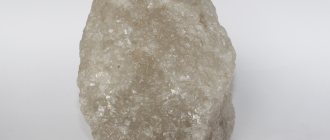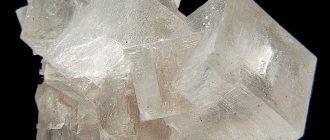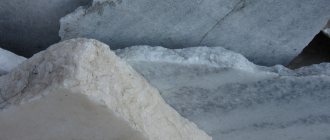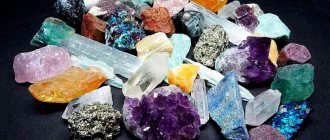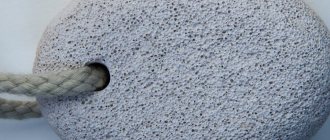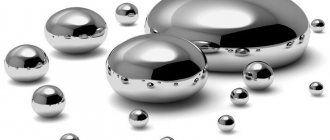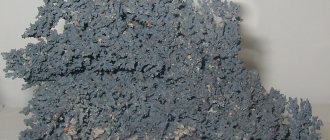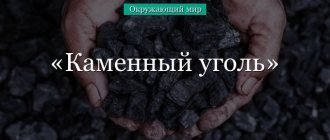CLAYS (a. clay; n. Tone; f. argiles; i. argilla) - sedimentary rocks consisting mainly of clay minerals; with water they form a plastic dough, which, when dried, can retain its given shape, and after firing, obtain the hardness of a stone.
- Characteristics and properties
- Classification and types
- Being in nature
- Groups:
- Low-melting clays
- Cement clay
- Fireproof and refractory
- Kaolin
- Adsorption clays
Clay, properties, types and varieties, origin, extraction and use.
Clay is a sedimentary rock with a fine-grained structure and complex composition. Plasticity, viscosity, fire resistance and other properties of clay are determined by which rock-forming substance is the main one.
Clay
Characteristics and properties of clay. “Fat” and “skinny” clays. Color. Water resistance. Plastic. Fire resistance. Caking ability
Types and varieties of clay
Origin of clay
Clay mining. Quarrying methods
Application and use of clay. Advantages
Properties of granite
Sand, clay, granite, limestone are minerals. If we look at granite in more detail, it is an igneous platonic rock of acidic composition. It is based on:
- potassium feldspar;
- plagioclase;
- quartz;
- biotite;
- muscovite
Granite is common in the continental crust. Its density reaches 2600 kg/m³, while the compressive strength is 300 MPa. The material begins to melt at 1215 °C. In the presence of pressure and water, the melting point decreases to 650 °C.
Granite is the most important rock of the earth's crust, it is widespread and makes up the majority of all components. Among the varieties of granites, alaskite and plagiogranite can be distinguished. The latter has a light gray color with a sharp predominance of plagioclase. Alaskite is a pink granite, it contains a sharp predominance of potassium-sodium feldspar.
Clay:
Clay is a sedimentary rock with a fine-grained structure and complex composition. Plasticity, viscosity, fire resistance and other properties of clay are determined by which rock-forming substance is the main one.
These can be clay materials such as kaolinite (Al2O3 2SiO2 2H2O), andalusite, disthene and sillimanite (Al2O3 SiO2), montmorillonite (MgO Al2O3 3SiO2 1.5H2O), halloysite (Al2O3 SiO2 H2O), hydrargillite (Al2O3 3H2O), diaspore (Al2O3 H2O), corundum (Al2O3), monothermite (0.2[K2MgCa]O Al2O3 2SiO2 1.5H2O), muscovite (K2O Al2O3 6SiO2 2H2O), nacrite (Al2O3·SiO2·2H2O) and pyrophyllite (Al2O3·4SiO2·H2O).
For example, montmorillonite, which belongs to layered silicates, has sorption properties and has a pronounced ability to swell strongly.
Different types of clay may contain particles of kaolinite, andalusite, muscovite, hydrargillite, nacrite, corundum, pyrophyllite and other constituent minerals in different proportions.
Among the impurities, the most common particles are quartz, gypsum, calcium, dolomite, pyrite, siderite, magnetite, and glauconite.
How to choose
Skin care for the face and neck requires an individual approach. Therefore, you need to choose a product based on the problems that concern the owner of a particular type of epidermis. Knowing the healing properties of each type of clay, you can make the right choice. To choose a cosmetic powder, you need to know your skin type. Dry, oily, normal and combination skin need their own separate components to improve its structure. A consultation with a cosmetologist will help you determine your skin type and choose the right clay to apply at home. Read about which clay to choose for your face here.
Characteristics and properties of clay:
The characteristics of clay materials depend on their composition, granule size, moisture content of the material, and location of extraction. When assessing the properties of clay, a whole range of characteristics is used - from density and solubility in water to porosity and thermal conductivity.
Main properties of clay:
– when it gets into water, it gets wet and breaks up into separate particles, forming a suspension or forms a mass similar to dough;
– in a dry state it has the structure of dust, in a wet state it becomes soft, plastic, and easily takes any shape;
– after drying or firing, it becomes strong and durable. As it dries, it decreases slightly in volume due to natural shrinkage;
– when moistened, it has good binding abilities. Thanks to these qualities, it is used in the manufacture of bricks and some types of dishes;
– clay in a wet state has good covering qualities, so in the past it was often used for coating wood-burning stoves, walls of houses and outbuildings;
– this material is capable of absorbing substances dissolved in liquids. Sorption properties make it possible to use it for filtration and purification from foreign impurities of vegetable fats and petroleum products.
Technologies for processing clay , changing its composition or “fat content” make it possible to obtain raw materials with specified properties - the desired shade, with greater fire resistance, less shrinkage, etc.
How to make masks
The traditional way to prepare a face mask at home is to combine purified water or herbal decoction, as well as the clay powder itself: 2 tbsp. l. liquid component per 3 tbsp. l. clay. As soon as the liquid is well absorbed into the powder, the base is mixed until smooth so that there are no lumps left.
Method of preparing, applying and washing off a clay mask.
Otherwise, applying the product will not give the desired effect. The structure of the prepared mass should be similar to thick sour cream.
Clay loves light, so before applying a mask based on it, you should leave it in the sun or under a daylight lamp.
Mixing is carried out only with a wooden spatula or spoon. The homemade mask is left on for 40-60 minutes. in a warm place, then add a little essential oil. Its quantity will depend on the purpose of use. For oily skin, fruit or vegetable juices are used instead of water, and lemon and lavender essential oils are added. For dry and normal skin, honey, milk, olive oil and egg yolks are perfect.
“Fat” and “skinny” clays:
Changing the proportions of the main components and impurities makes the clay “lean” or “fat”. The plasticity of the material and the quality of the final product depend on this property.
Products made from too “oily” clay deteriorate during the drying or firing stage - they become covered with cracks or warp. The use of thinning additives makes it possible to reduce the shrinkage of the material during natural drying or heat treatment. Sand is most often used as such an additive: fine, medium fine or coarse. It is thoroughly washed to get rid of dust, as it reduces the viscosity of the clay mass.
“Skinny” clay has low plasticity and is unsuitable for modeling or molding. To improve plastic properties, elutriation technology is used. This is the enrichment of material by separating clay particles from impurities. After diluting the raw material with water, slowly settling clay particles are filtered from heavier sand and stones.
Contraindications
Home clay procedures may have contraindications for use. You should not make clay masks if you have diseases of the circulatory system or if there is an exacerbation of individual chronic diseases. Any cosmetic mixture made from clay can cause allergic reactions. Most often, they appear not from the clay itself, but from some components of the mask. It should not be used for chronic skin diseases. First, a test smear of clay is made on the inner bend of the elbow and the reaction is observed. If there is redness and burning, you should stop using the mask for a while.
Before using a clay mask, you must perform an allergy test. To do this, apply a small amount of clay to the inside of the forearm and wait a few hours; if itching and burning does not occur, then you can apply the mask to the face.
Clay masks are prohibited for women during pregnancy and during the menstrual cycle. Pure clay is contraindicated for women with aging skin of any type, since after its use the level of moisture in the skin decreases to a critical level.
Clay color:
The color of the breed can be yellow, brown, blue, greenish, black. The color depends on the concentration of chromophores - unsaturated atoms. Cobalt compounds give the material a blue tint, chromium makes it olive, and admixtures of magnesium and nickel make it brown and gray. After firing, clay products become red or white.
Clay minerals
Clay Physico-chemical properties
Hydromica Kaolshshtov Montmorillonite and beidellite clays
Limits of change in refractive indices Birefringence The appearance of particle aggregates under a conventional microscope The appearance of particles in an electron microscope Color when stained with a 0.001% solution of methylene blue dye The same, with the addition of a saturated solution of KCl Color when stained with a saturated solution of benzidine hydrochloride Ability to swell Character of the heating curve 1.560-1.600 . 0.014-0.020 Elongated plates with sharply defined edges Elongated translucent and opaque plates with sharp outlines Violet-blue, blue Violet-blue, blue, light blue Dirty blue and gray-blue Insignificant Three endothermic reactions in the intervals of 100-150, 500- 600 and 850-900° and sometimes one exothermic reaction in the range 925-1020° 1.558-1.570 0.005-0.009 Isometric or elongated plates with uneven edges Hexagonal opaque plates and irregularly shaped particles with sharply defined edges Faded light purple Faded light purple Not colored Insignificant Endothermic reaction in the range of 500-600° and two exothermic reactions in the ranges of 900-1050 and 1100-1200°. Sometimes another small endothermic reaction in the range of 100-150° (in plastic fine clays and in clays with an admixture of halloysite)
In some cases, the suitability of clays can be determined by their appearance. Thus, bright red or brown clays, containing many iron compounds, cannot be fireproof and ceramic. If such brightly colored clays are homogeneous and do not contain large inclusions of carbonates, then they can be brick. If they are fine-grained, they can be used as pottery paints, and if they contain a significant amount of iron oxides, they belong to the group of mineral paints.
Clays that are white, light gray, light yellow, light pink, and light green can be refractory, refractory, or even fusible if they are composed of montmorillonite. Clays of dark gray and black color can sometimes be refractory, and, conversely, even very light clays may not be refractory if they contain significant amounts of carbonates, salts, gypsum and other fusible minerals.
Non-wetting stone-like clays with conchoidal fracture can be fire-resistant. Clays, pieces of which, when immersed in water, when soaked, swell greatly and retain their shape for a long time, always turn out to be absorbent.
Fire resistance of clay:
According to their ability to withstand high temperatures without loss of strength, clay materials are:
– low-melting. Their processing is carried out at a temperature of +1350 °C. They are used in the production of facing bricks, tiles, decorative wall masonry elements;
– refractory. The minimum amount of impurities in the composition makes it possible to process at higher temperatures - up to +1580 °C. They are used in the production of facing building materials and sewer pipes;
– fireproof. Materials of this group contain virtually no impurities in their composition, so their melting requires a temperature above +1580 °C. They are mainly used in the production of fireclay bricks for lining stoves, laying fireplaces, and chimneys.
Results
- The mask is a kind of peeling, helps normalize the functioning of the sebaceous glands, nourishes and moisturizes, disinfects, gives the skin firmness and elasticity, heals the dermis and deeply cleanses the pores.
- Each type of clay has its own individual properties, so their use is possible for any skin type.
- Mixing different types of mineral enhances their effect.
- Clay itself has no contraindications and is therefore safe for use.
- You can use masks at any time of the year, but they are especially effective in summer and winter, when the level of stress on the skin from ultraviolet radiation or cold is quite high.
A high-quality homemade clay mask requires adherence to exact proportions, as well as proper application to the skin and storage conditions. Read about recipes on how to make a clay mask at home here.
Clay sinterability:
This property is defined as the ability of a plastic material to transform into a solid, stone-like state when fired at high temperatures. Clay after firing should not soak in water. This property is acquired due to irreversible changes in the structure of the material, namely, the removal of physically bound water, the decomposition of clay material into silicon oxide and aluminum oxide. At temperatures from +1000 °C to +1200 °C, new water-resistant mineral compounds are formed. The melt of fusible components solidifies when cooled, making the mass hard and durable.
Montmorillonite clays Clay rocks of the montmorillonite group
Montmorillonite clays were previously called fulling clays in connection with their use for degreasing wool during felting, as well as bleaching clays or fuller's earths. Currently, they are more often called bentonites and floridins. In addition to montmorillonite and nontronite, these rocks also contain mixed-layer formations, most often montmorillonite-hydromica, similar in composition to the montmorillonite group. Some varieties of montmorillonite clays swell greatly when immersed in water.
Types and varieties of clay:
In industry, construction, and cosmetology, clays of different composition, characteristics, and color are used. The division of materials into types is determined by a combination of properties such as plasticity, sinterability, fire resistance, and the amount of impurities. The most common are:
– kaolin (white) clay . White clay is used in the production of porcelain and earthenware;
- blue clay. In demand in cosmetology and medicine;
– bentonite clay . When preparing an aqueous solution, it increases in volume several times. This property makes it indispensable in the construction of pile foundations and drilling wells;
– fireclay clay . Used in the production of fire bricks;
– shale clay . Shale is used to make cement;
– pottery (lump) clay . Lump clay is used to make pottery;
– montmorillonite (full) clay . It is used to purify products such as molasses, beer, wine, syrups, juices, oils, petroleum products, and is also used as an improving additive in the manufacture of soap.
Basic properties
Clay is a mineral that has a number of properties, among them the following should be highlighted:
- air and fire shrinkage;
- plastic;
- sinterability;
- fire resistance;
- viscosity;
- color of ceramic shard;
- porosity;
- shrinkage;
- dispersion;
- swelling.
Clay is the most stable waterproofing material that does not allow moisture to pass through, which is one of the important qualities. Clay soil has stability. It is developed in wastelands and wastelands. The development of root vegetation in clay deposits is impossible.
To preserve the quality of groundwater, the material's water-impermeability is useful. Most of the high-quality artesian springs lie between the clay layers.
Origin of clay:
Clay is a naturally occurring product formed from feldspar and igneous rocks that has a fine texture when dry. By origin, these rocks are continental, formed on the mainland, and marine, formed at the bottom of the sea.
As a result of shifts in earth layers, earthquakes, and floods, granites, volcanic glass, tuffs, and porphyrites were crushed. The physical change and destruction of rocks was influenced by the crystallization of salts, freezing of water, and the vital activity of microorganisms.
The formation of sea clay layers occurred when clay substances were deposited by water currents, accumulated and settled. Clays of the marine group are:
– coastal-sea. Their place of formation is coastal regions, river deltas and bays. Clay layers often alternate with coal, sand, and silt;
– lagoon. Clays formed in sea lagoons contain high concentrations of sulfides, calcite, and iron. Fire-resistant species are common among lagoonal alluvial rocks;
– shelf. Rocks that were formed at a depth of more than 200 m have a denser structure and homogeneous composition.
Continental clays are also divided according to their place of origin. They are:
– deluvial. A characteristic feature is the mixed composition, its heterogeneity even in one time layer;
– lake. The best fire-resistant clays are formed precisely on the bottom and shores of lakes. They contain all the components necessary for the manufacture of fireclay materials;
– proluvial. They are formed by the destruction of rocks, washed away and carried along erosion furrows to the foot of the mountains. Their characteristic feature is layering, looseness, heterogeneous composition;
– river. They can be found in river floodplains; they contain a large amount of impurities in their composition and most often turn into pebbles.
There are also residual rocks with low plasticity, formed as a result of weathering of rocks.
Clay mining. Quarrying methods:
In our country, clay mining is carried out in the Urals, Eastern and Western Siberia. Often several types of clay are produced at one deposit. There are 3 groups according to the difficulty of quarrying:
- first group. Development of the top layers of soil with plant residues, work is underway to excavate loam;
- second group. This is compacted rock, saturated with moisture, as well as deposits of lumpy rocks, with admixtures of gravel;
- third group. The development of hardened shale strata and frozen clay soil is underway.
Quarry development methods depend on the volume and depth of deposits and their location. The most common method of extracting clay-containing rocks is the extraction of minerals using special equipment - gear hobbing excavators. Rock blasting is used in deep mining of large deposits. Kaolin white and blue clay is mined using devices that create a dense water jet. Most often, hydromonitors are used when the layer humidity is high.
Extraction of materials for ceramics manufacturing enterprises is carried out using gear hobbing excavators by cutting layers of different thicknesses. Before development begins, preparations are carried out:
– laying access roads;
– clearing the quarry horizon;
– delivery of equipment.
The developed soil and sand are removed from the quarry and poured into a dump, and the clay is transported to its destination. If several varieties of clays are found in one deposit, the development of the layers is carried out separately. This technology is called “Selective Generation”. It is more efficient than bulk mining, in which all layers are cut off at the same time.
Application and use of clay:
When dry clay is combined with water, a plastic mass is formed. Depending on the place of production and composition, it is used in a variety of fields and industries:
– production of ceramics . This is one of the main uses of clay. Different varieties are used to make ceramics, earthenware, and porcelain. These materials are used to make dishes, figurines, vases, and souvenirs. Although pottery has been known for a very long time, it continues to improve even now;
– production of building materials . Clay is the main component of mortars that are used in the manufacture of facing and masonry bricks and tiles. Clay or ceramic tiles are considered one of the best roofing materials. It is durable, strong, frost-resistant, holds heat well, and does not make noise when it rains;
– cement production . For the production of cement, shale is used, which contains 22% silicon dioxide, 5% calcium oxide. The clay content in cement does not exceed 25%, the second component, limestone, accounts for 75%. The components are diluted with water, and the resulting mass is sent for firing. The resulting granulated clinker is cooled, crushed to dust, and 5% gypsum is added;
– technical ceramics . This category includes a fairly large group of ceramic products, which are characterized by increased hardness, heat resistance, resistance to abrasive wear and mechanical deformation. The main types of technoceramics are structural, instrumental, electro-radiotechnical, ceramics with special properties. These are plumbing fixtures, electrical insulators, thread-conducting fittings, rollers, couplings, bushings. Corundum ceramic materials are used in the production of armor panels and body armor.
Place of Birth
Natural accumulations of rocks are called deposits. The territory of Russia is rich in reserves of various types of clays. For the ceramic industry, deposits of pure rocks that contain few impurities are of great interest. They belong to kaolin and refractory clays. Mining of ordinary (light-melting) varieties in Russia is carried out almost everywhere. But deposits of refractory and blue clay are much less common.
Clay mining in Russia is carried out in such deposits as Kashtymskoye, Nevyanskoye, Astafievskoye, Palevskoye. Each of them has its own characteristics depending on the conditions of formation, chemical and mineral composition.
Deposits of fire-resistant species are much more common than kaolin deposits. But at the same time, the most numerous are the places where refractory varieties are adjacent to fire-resistant ones. In Russia, the most famous among them are the Troshkovskoye, Latnenskoye and Gzhelskoye fields.
But the main places for bentonite production are the Gumbrian, Aksan and Oglalinskoye deposits.
The location for clay extraction is always selected depending on the quality of the raw materials, the volume of reserves and the economic benefits of their development.
